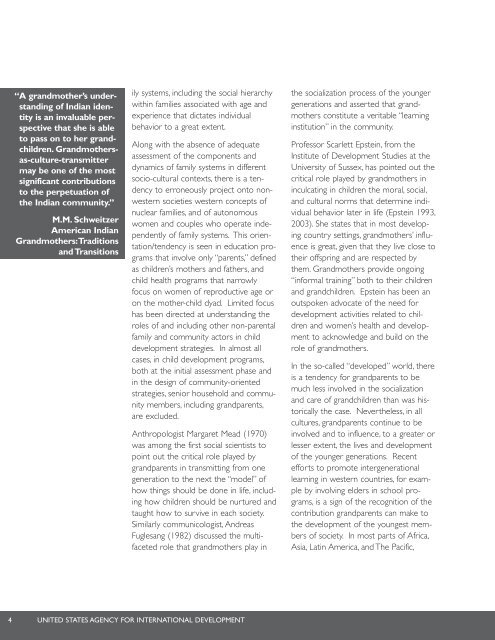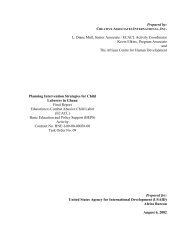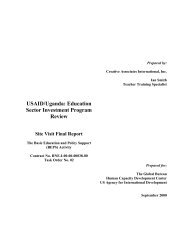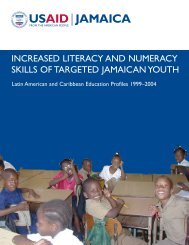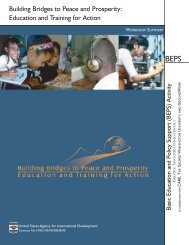“A gr<strong>and</strong>mother’s underst<strong>and</strong>ingof Indian identityis an invaluable perspectivethat she is ableto pass on to her gr<strong>and</strong>children.<strong>Gr<strong>and</strong>mothers</strong>as-culture-transmittermay be one of the mostsignificant contributionsto the perpetuation ofthe Indian community.”M.M. SchweitzerAmerican Indian<strong>Gr<strong>and</strong>mothers</strong>:Traditions<strong>and</strong> Transitionsily systems, including the social hierarchywithin families associated with age <strong>and</strong>experience that dictates individualbehavior to a great extent.Along with the absence of adequateassessment of the components <strong>and</strong>dynamics of family systems in differentsocio-cultural contexts, there is a tendencyto erroneously project onto nonwesternsocieties western concepts ofnuclear families, <strong>and</strong> of autonomouswomen <strong>and</strong> couples who operate independentlyof family systems. This orientation/tendencyis seen in education programsthat involve only “parents,” definedas children’s mothers <strong>and</strong> fathers, <strong>and</strong>child health programs that narrowlyfocus on women of reproductive age oron the mother-child dyad. Limited focushas been directed at underst<strong>and</strong>ing theroles of <strong>and</strong> including other non-parentalfamily <strong>and</strong> community actors in childdevelopment strategies. In almost allcases, in child development programs,both at the initial assessment phase <strong>and</strong>in the design of community-orientedstrategies, senior household <strong>and</strong> communitymembers, including gr<strong>and</strong>parents,are excluded.Anthropologist Margaret Mead (1970)was among the first social scientists topoint out the critical role played bygr<strong>and</strong>parents in transmitting from onegeneration to the next the “model” ofhow things should be done in life, includinghow children should be nurtured <strong>and</strong>taught how to survive in each society.Similarly communicologist, AndreasFuglesang (1982) discussed the multifacetedrole that gr<strong>and</strong>mothers play inthe socialization process of the youngergenerations <strong>and</strong> asserted that gr<strong>and</strong>mothersconstitute a veritable “learninginstitution” in the community.Professor Scarlett Epstein, from theInstitute of Development Studies at theUniversity of Sussex, has pointed out thecritical role played by gr<strong>and</strong>mothers ininculcating in children the moral, social,<strong>and</strong> cultural norms that determine individualbehavior later in life (Epstein 1993,2003). She states that in most developingcountry settings, gr<strong>and</strong>mothers’ influenceis great, given that they live close totheir offspring <strong>and</strong> are respected bythem. <strong>Gr<strong>and</strong>mothers</strong> provide ongoing“informal training” both to their children<strong>and</strong> gr<strong>and</strong>children. Epstein has been anoutspoken advocate of the need fordevelopment activities related to children<strong>and</strong> women’s health <strong>and</strong> developmentto acknowledge <strong>and</strong> build on therole of gr<strong>and</strong>mothers.In the so-called “developed” world, thereis a tendency for gr<strong>and</strong>parents to bemuch less involved in the socialization<strong>and</strong> care of gr<strong>and</strong>children than was historicallythe case. Nevertheless, in allcultures, gr<strong>and</strong>parents continue to beinvolved <strong>and</strong> to influence, to a greater orlesser extent, the lives <strong>and</strong> developmentof the younger generations. Recentefforts to promote intergenerationallearning in western countries, for exampleby involving elders in school programs,is a sign of the recognition of thecontribution gr<strong>and</strong>parents can make tothe development of the youngest membersof society. In most parts of Africa,Asia, Latin America, <strong>and</strong> The Pacific,4 UNITED STATES AGENCY FOR INTERNATIONAL DEVELOPMENT
gr<strong>and</strong>parents continue to play a criticalrole in guiding <strong>and</strong> supervising the youngergenerations; parents <strong>and</strong> children alike. Invirtually all cases it is the gr<strong>and</strong>motherswho play a greater <strong>and</strong> more direct role ina child’s development than do gr<strong>and</strong>fathers,though this does not deny theinvolvement of gr<strong>and</strong>fathers in someaspects of a child’s overall development.It is important to note that in this review“gr<strong>and</strong>mother” is used as a “generic” termto refer not only to biological or paternalgr<strong>and</strong>mothers but to all of the older, experiencedwomen in a family who serve asadvisors to younger family members onmultiple aspects of child <strong>and</strong> family development.In addition to the veritablegr<strong>and</strong>mothers, this can include aunts <strong>and</strong>unmarried senior women who play a roleas family advisors. In patrilineal societies,the child’s gr<strong>and</strong>mother is the woman’smother-in-law.Clearly traditional family <strong>and</strong> communitystructures are in transition in virtually allsocieties. In this context, it is important toask ourselves, “Do child development programsserve to bolster traditional family<strong>and</strong> community structures, roles <strong>and</strong> values,including the role of experienced, seniorfamily members, for the benefit of children<strong>and</strong> their families?” Or, “Are childdevelopment programs merely acquiescingto the increasing rift between local, traditionalroles, values, <strong>and</strong> resources <strong>and</strong> globalizingforces of ‘modernity’ <strong>and</strong> ‘individualism’that is contributing to breaking downthe social cohesion of more traditionalcommunities systems around the world?”CONCEPTUAL FRAMEWORKThis review of literature, policy, <strong>and</strong> programsis framed by several key conceptsthat are often not given much attention inthe design of child development programs.These concepts include a systemsapproach; an assets-based approach; culturalstructures; roles <strong>and</strong> values as a foundationfor program design; respect for elders<strong>and</strong> their experience; <strong>and</strong> social capital.Each of the concepts is explained below,along with its relevance to the discussionof gr<strong>and</strong>mothers’ involvement in childdevelopment programs. As will be seen,each of these concepts has implications forhow child development strategies <strong>and</strong> programsare designed, both in terms of analyzingcommunity realities <strong>and</strong> in developinginterventions.• Systems ApproachIn many past child development programsthere has been a tendency toadopt a reductionist approach thatfocuses only on children, or on thechild-mother dyad. This approach simplifiesthe parameters dealt with bothin initial assessments <strong>and</strong> in programdesigns. However, such an approach isinadequate in so far as it provides alimited vision of the household systemof which children are a part. Thisrestricted focus on only certain membersof the household necessarily concealsthe roles of household actors inaddition to mothers, namely older siblings,men, <strong>and</strong> senior women, <strong>and</strong> theinfluence they have on each otherrelated to children’s well-being. In contrast,in a systems approach children’sneeds are analyzed <strong>and</strong> addressed in" Successful programsuse the existingstrengths of communities,families, <strong>and</strong>social structures….toprovide the best forchildren."UNICEFThe State of theWorld's Children:Early ChildhoodGRANDMOTHERS:THE LEARNING INSTITUTION5
- Page 1 and 2: GRANDMOTHERS:A LEARNING INSTITUTION
- Page 3: GRANDMOTHERS:A LEARNING INSTITUTION
- Page 11 and 12: EXECUTIVE SUMMARYSociety itself fai
- Page 13 and 14: Education, the Bernard Van LeerFoun
- Page 15 and 16: SEVERAL FACTORS CONTRIBUTE TO THELI
- Page 17: - Who am I? Assign children to askf
- Page 20 and 21: in educational activities on home t
- Page 24 and 25: “Culture tells peoplehow to view
- Page 26 and 27: attention given to grandmothers’
- Page 28 and 29: social work, including family syste
- Page 30 and 31: mation from Azerbaijan (McNulty 200
- Page 32 and 33: “The status of eldersin tradition
- Page 34 and 35: “As women, thegrandmothers haveli
- Page 36 and 37: members often consult the moreexper
- Page 38 and 39: “Social capital is a community’
- Page 40 and 41: In a collaborative effort between
- Page 42 and 43: in-laws and the additional free tim
- Page 44 and 45: "Involving grandmothersin community
- Page 50 and 51: CULTURALLY-ADAPTED EDUCATIONMATERIA
- Page 52 and 53: strated the power of participatory
- Page 54 and 55: effects of the new ideas, their con
- Page 57 and 58: V. GRANDMOTHERS: A LEARNING INSTITU
- Page 59 and 60: Many health and development workers
- Page 61 and 62: VI. RECOMMENDATIONS FORBASIC EDUCAT
- Page 63 and 64: parents themselves did not go to sc
- Page 65 and 66: community ties by increasing teache
- Page 67 and 68: of millions. On the other hand, som
- Page 69: teachers, teacher abuse of children
- Page 73 and 74:
APPENDIX B:ANNOTATEDREFERENCES ON T
- Page 75 and 76:
acceptable for younger women to mak
- Page 77 and 78:
showed that men are not directly in
- Page 79 and 80:
ecause they had more time to devote
- Page 81 and 82:
matrilineal or patrilineal areas
- Page 83 and 84:
diet, work, fetal development, sexu
- Page 85 and 86:
in the family and social networks.
- Page 87 and 88:
elated, for example, to early child
- Page 89 and 90:
REFERENCESAdams, A. M., S. Madhavan
- Page 91 and 92:
BASICS and LINKAGES. 1998. Influenc
- Page 93 and 94:
Childhood Education and Development
- Page 95 and 96:
Krishna, A. and N. Uphoff. June 199
- Page 97 and 98:
Sear, R., R. Mace, and I. A. McGreg
- Page 99 and 100:
ABOUT THE AUTHORThis review was pre


